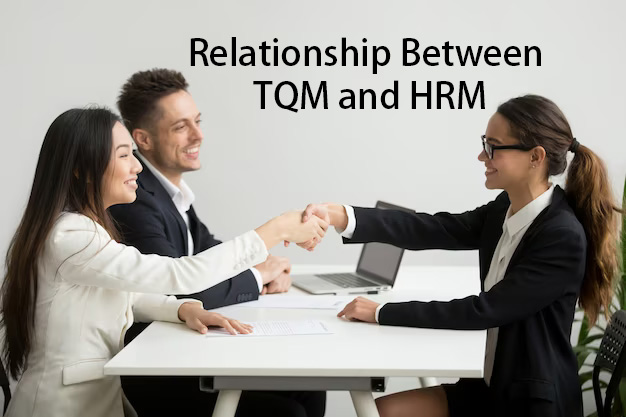Relationship Between TQM and HRM
Relationship Between TQM and HRM: Two of the most pivotal organizational philosophies that make an impact in determining whether businesses will succeed or fail today is Total Quality Management TQM and Human resource management HRM. Although the philosophy of TQM revolves around continuous and lasting improvement in processes as well as products, HRM is more concerned with how to control and develop that which really constitutes an organization’s value base—its human resources.

Also See: Redeployment in HRM: Meaning, Benefits, Steps
This article analyzes the relationship and synergy between TQM and HRM, explaining how their combination can develop a culture based on efficiency, employee involvement, continuous growth of an organisation.
Relationship Between TQM and HRM
Understanding TQM:
TQM is a comprehensive management approach that originated in the 1950s and gained prominence in the 1980s and 1990s. It is centered around the idea of continuous improvement, customer satisfaction, and employee involvement. TQM seeks to optimize processes, eliminate defects, and enhance overall organizational performance by involving every employee in the pursuit of quality. The core principles of TQM include customer focus, employee involvement, process improvement, and fact-based decision-making.
The Essence of HRM:
HRM, on the other hand, is a strategic approach to managing an organization’s workforce. It encompasses recruitment, training, performance management, employee relations, and talent development. HRM aims to align the workforce with the organization’s goals and create a work environment that encourages employee productivity, satisfaction, and retention. The key elements of HRM include recruitment and selection, training and development, performance management, and employee relations.
Also See: Domestic Human Resource Management: Definition and Components
The Integration of TQM and HRM:
The relationship between TQM and HRM is symbiotic, as both philosophies share common goals and principles. The integration of TQM and HRM is crucial for organizations striving to achieve and sustain high levels of quality and excellence. Here are several key areas where TQM and HRM intersect and complement each other:
- Employee Training and Development:
- TQM emphasizes the need for ongoing training to enhance employees’ skills and knowledge.
- HRM takes charge of identifying training needs, designing programs, and ensuring employees receive the necessary education.
- The collaboration ensures that employees are equipped with the skills required to contribute effectively to continuous improvement efforts.
- Employee Involvement and Empowerment:
- TQM relies on the active involvement of all employees in decision-making processes and continuous improvement initiatives.
- HRM promotes employee empowerment by fostering a culture of open communication, trust, and shared responsibility.
- When TQM and HRM collaborate, organizations create an environment where employees feel empowered to contribute ideas, voice concerns, and actively participate in quality enhancement initiatives.
Also See: Warwick Model of HRM: Meaning, Elements and Advantages
- Performance Management:
- TQM requires a systematic approach to performance measurement and improvement.
- HRM oversees performance management processes, ensuring that employees’ goals align with organizational objectives.
- The integration ensures that performance metrics are tied to quality outcomes, creating a results-oriented and performance-driven culture.
- Communication and Teamwork:
- TQM emphasizes the importance of effective communication and teamwork to achieve organizational objectives.
- HRM plays a critical role in fostering communication channels and building cohesive, high-performing teams.
- Together, TQM and HRM create an organizational culture that values collaboration, communication, and collective problem-solving.
- Employee Recognition and Rewards:
- TQM recognizes the significance of acknowledging and rewarding employees for their contributions to quality improvement.
- HRM manages reward systems, ensuring that they are aligned with organizational goals and encourage behaviors that promote quality and excellence.
- The integration ensures that employees are recognized and rewarded for their commitment to continuous improvement and achieving quality benchmarks.
Also See: 5p Model Of Hrm: Meaning, Purpose With Diagram
Conclusion:
In conclusion, the relationship between TQM and HRM is pivotal for organizations striving for excellence, quality, and sustained success. The integration of these two philosophies creates a powerful synergy that aligns human capital efforts with the pursuit of continuous improvement and customer satisfaction. As organizations navigate the complexities of the modern business environment, the harmonious collaboration between TQM and HRM becomes a cornerstone for fostering a culture of excellence & employee engagement.
Leave a Reply